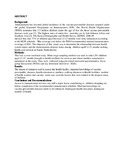Health system determinants of childhood immunization dropout in Narok North district, Kenya

View/
Date
2014-11Author
Kiio, Francis
Njoroge, Peter
Nyabola, Lambert
Language
enMetadata
Show full item recordAbstract
Background:
Immunization has lowered global incidence of the vaccine-preventable diseases targeted under the global Expanded Programme on Immunization (EPI). The World Health Organization (WHO) estimates that 2.5 million children under the age of five die from vaccine-preventable diseases each year [1]. The highest rates of under-five mortality are in Sub-Saharan Africa and Southern Asia [2]. The Kenya Demographic and Health Survey (KDHS) 2008-09
showed that only 77% of children aged between 12-23 months were fully immunized according to the KEPI schedule. This coverage was below the WHO recommended national immunization coverage of 90%. The objective of this study was to determine the relationship between health system inputs and the immunization dropout status among children aged 12-23 months seeking health care services in Narok North district.
Methods:
This was a cross-sectional study. Multi-stage sampling method was used to select 291 children aged 12-23 months brought to health facilities for services and whose mothers consented to participate in the study. Data were collected using pre-tested structured questionnaires, focus group discussions (FGDs) and key informant interviews (KIIs).
Results:
The means of transport used to access the health facility, maternal knowledge of vaccine-preventable diseases, health education to mothers, walking distances to health facilities, number of health workers and vaccine stock-outs were the factors that were related to the dropout status of children.
Conclusions and Recommendations:
Access to immunization services was still a major factor contributing to children dropping out before completion of the recommended immunization schedule. Maternal knowledge on vaccine-preventable diseases needs to be enhanced. Inadequate health education, inadequate number of health
URI
http://www.ahaic.org/wp-content/uploads/2014/12/Ahaic-2014-Abstracts-Book.pdfhttp://hdl.handle.net/11295/81521
Citation
Kiio Francis., Njoroge Peter., and Nyabola Lambert, (2014). Health system determinants of childhood immunization dropout in Narok North district, Kenya. Amref health Africa international conference. November 24 - 26, 2014 Nairobi, kenya. (book of abstracts, p.95)Publisher
University of Nairobi
